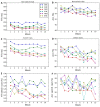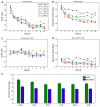The Influence of Feedback on Task-Switching Performance: A Drift Diffusion Modeling Account
- PMID: 29456494
- PMCID: PMC5801306
- DOI: 10.3389/fnint.2018.00001
The Influence of Feedback on Task-Switching Performance: A Drift Diffusion Modeling Account
Abstract
Task-switching is an important cognitive skill that facilitates our ability to choose appropriate behavior in a varied and changing environment. Task-switching training studies have sought to improve this ability by practicing switching between multiple tasks. However, an efficacious training paradigm has been difficult to develop in part due to findings that small differences in task parameters influence switching behavior in a non-trivial manner. Here, for the first time we employ the Drift Diffusion Model (DDM) to understand the influence of feedback on task-switching and investigate how drift diffusion parameters change over the course of task switch training. We trained 316 participants on a simple task where they alternated sorting stimuli by color or by shape. Feedback differed in six different ways between subjects groups, ranging from No Feedback (NFB) to a variety of manipulations addressing trial-wise vs. Block Feedback (BFB), rewards vs. punishments, payment bonuses and different payouts depending upon the trial type (switch/non-switch). While overall performance was found to be affected by feedback, no effect of feedback was found on task-switching learning. Drift Diffusion Modeling revealed that the reductions in reaction time (RT) switch cost over the course of training were driven by a continually decreasing decision boundary. Furthermore, feedback effects on RT switch cost were also driven by differences in decision boundary, but not in drift rate. These results reveal that participants systematically modified their task-switching performance without yielding an overall gain in performance.
Keywords: drift diffusion model; executive function; feedback; learning; task-switching; training.
Figures









Similar articles
-
Task Switching: On the Relation of Cognitive Flexibility with Cognitive Capacity.J Intell. 2023 Mar 30;11(4):68. doi: 10.3390/jintelligence11040068. J Intell. 2023. PMID: 37103253 Free PMC article.
-
Effects of aging in a task-switch paradigm with the diffusion decision model.Psychol Aging. 2020 Sep;35(6):850-865. doi: 10.1037/pag0000562. Epub 2020 Jul 27. Psychol Aging. 2020. PMID: 32718157 Free PMC article.
-
Cross-modal transfer after auditory task-switching training.Mem Cognit. 2019 Jul;47(5):1044-1061. doi: 10.3758/s13421-019-00911-x. Mem Cognit. 2019. PMID: 30805872
-
Task switching and the measurement of "switch costs".Psychol Res. 2000;63(3-4):212-33. doi: 10.1007/s004269900003. Psychol Res. 2000. PMID: 11004877
-
Task-switching in pigeons: Associative learning or executive control?J Exp Psychol Anim Learn Cogn. 2016 Apr;42(2):163-76. doi: 10.1037/xan0000100. J Exp Psychol Anim Learn Cogn. 2016. PMID: 27054382
Cited by
-
Fentanyl reinforcement history has sex-specific effects on multi-step decision-making.bioRxiv [Preprint]. 2025 Jun 5:2024.10.10.617707. doi: 10.1101/2024.10.10.617707. bioRxiv. 2025. PMID: 40501615 Free PMC article. Preprint.
-
Task Switching: On the Relation of Cognitive Flexibility with Cognitive Capacity.J Intell. 2023 Mar 30;11(4):68. doi: 10.3390/jintelligence11040068. J Intell. 2023. PMID: 37103253 Free PMC article.
-
Predictive markers in estimating the need for early intensive care in patients with adhesive small bowel obstruction in the emergency department.J Minim Access Surg. 2023 Oct-Dec;19(4):535-539. doi: 10.4103/jmas.jmas_189_23. J Minim Access Surg. 2023. PMID: 37843164 Free PMC article.
-
Human ageing is associated with more rigid concept spaces.Psychon Bull Rev. 2023 Apr;30(2):722-730. doi: 10.3758/s13423-022-02197-8. Epub 2022 Oct 17. Psychon Bull Rev. 2023. PMID: 36253591
References
LinkOut - more resources
Full Text Sources
Other Literature Sources

